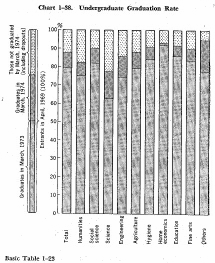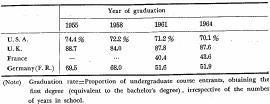| Home > Policy > White Paper, Notice, Announcement > White Paper > EDUCATIONAL STANDARDS IN JAPAN 1975 > CHAPTER1 4 (4) | ||
Of the students admitted to 4-year undergraduate courses in April, 1969, those graduated in March, 1973 after four years of study, accounted for 79.1% as against 8.8% for those graduated in March, 1974 after a five years of study with one extra-year repetition. The remaining 12.1% are presumed to be students expected to graduate after six years or more of study (with repetition of two or more extra years), plus those leaving universities in mid-course.
As for the proportion of those graduated in four years and of those graduated after one extra-year repetition, classified by the field of specialization, the highest rate (92%) of those graduated in four years is registered by the students specializing in home economics and the second highest (86%) by those in education, while the lowest rate (63%) is shown by the students specializing in science.
In addition, the proportion of students graduated from four-year undergraduate courses in four years among those admitted in April, 1970 and in April, 1971 stood at 78.4% and 75.0% respectively. That is, this proportion has been slipping year by year.

The undergraduate graduation rate in several selected countries is shown in the following table. It indicates some differences in the graduation rate, but, in this regard, heed should be taken of the discrepancy of systems among those countries with respect to screening of applicants, post-admission tests and so on.

| Back to Top | MEXT HOME |